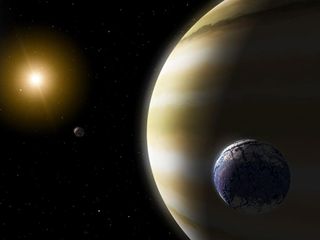Wandering Rogue Moons May Be As Common As Stars

Rogue moons, torn from their planets and flung outward to drift through space, may be as common as stars in the universe, a new study finds.
Moons are common in the solar system, with Jupiter alone possessing at least 67. As such, Yu-Cian Hong, an astrophysicist at Cornell University, wanted to see how moons around distant stars might behave, she said.
Previous research found that many giant exoplanets — that is, worlds orbiting distant stars — have oval-shaped or "eccentric" orbits. Prior work suggested that the most likely explanation for this orbital eccentricity was gravitational tug-of-war between exoplanets. This led Hong and her colleagues to investigate what effect this "planet-planet scattering" might have on the moons of those worlds.Hong's team discovered that the vast majority — about 80 to 90 percent — of the moons around giant exoplanets are removed from their original homes by planet-planet scattering. These exomoons can then go on to display some "wild behavior," Hong told Space.com. [The Strangest Alien Planets We Know]
For example, a destabilized moon may go on to collide with a planet or its star. The moon may end up kidnapped by another planet or may go on to orbit its star on its own as a "planet."
The researchers also found that planet-planet scattering may drive exoplanets and their moons to go "rogue" — that is, they may fly through space without stars, as free-floating bodies. In addition, exomoons may end up rogue on their own without host planets. In fact, rogue moons "may exceed the number of free-floating planets in the universe and could even be as numerous as stars," Hong said.
The exomoons most likely to survive planet-planet scattering are those that orbit close to their host planets and that orbit larger planets with stronger gravitational pulls, the researchers said. For instance, exomoons on orbits similar to those of Jupiter's four largest, "Galilean" moons have about a 20 to 40 percent chance of survival.
One way to see how often moons are in stable orbits around planets or are free-floating without host planets might be through NASA's upcoming Wide-Field Infrared Survey Telescope (WFIRST) infrared space observatory, although WFIRST might be in danger of cancellation. In the event the space telescope is not shut down, "I personally look forward to stable exomoons or free-floating moons being discovered with the upcoming WFIRST mission," Hong said.
Get the Space.com Newsletter
Breaking space news, the latest updates on rocket launches, skywatching events and more!
The scientists detailed their findings online Jan. 10 in the Astrophysical Journal.
Follow Charles Q. Choi on Twitter @cqchoi. Follow us @Spacedotcom, Facebook and Google+. Original article on Space.com.
Join our Space Forums to keep talking space on the latest missions, night sky and more! And if you have a news tip, correction or comment, let us know at: community@space.com.

Charles Q. Choi is a contributing writer for Space.com and Live Science. He covers all things human origins and astronomy as well as physics, animals and general science topics. Charles has a Master of Arts degree from the University of Missouri-Columbia, School of Journalism and a Bachelor of Arts degree from the University of South Florida. Charles has visited every continent on Earth, drinking rancid yak butter tea in Lhasa, snorkeling with sea lions in the Galapagos and even climbing an iceberg in Antarctica. Visit him at http://www.sciwriter.us
